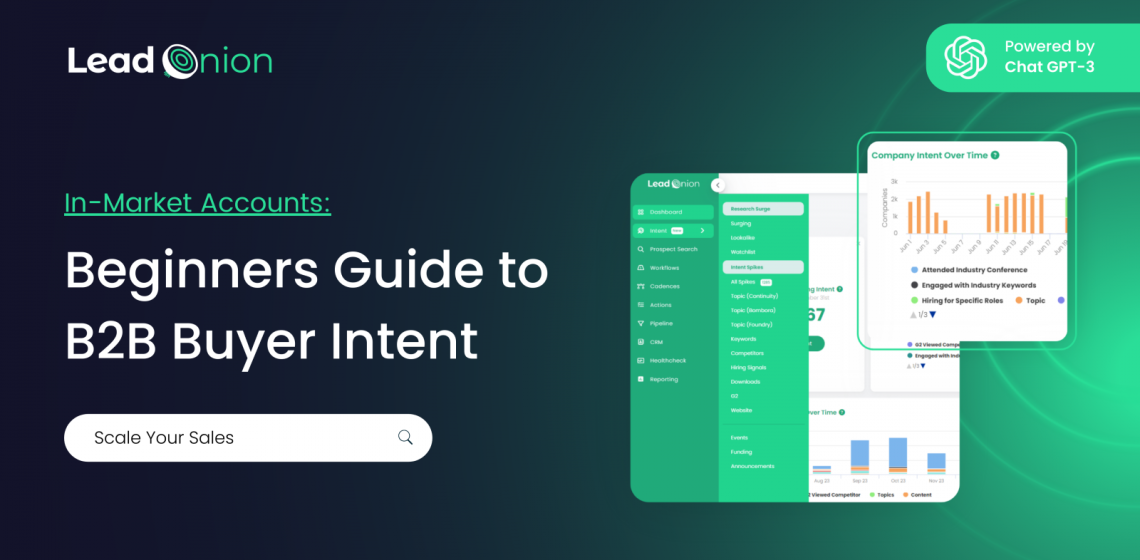In today's competitive market, understanding B2B buyer intent is crucial for creating effective marketing strategies. Leveraging buyer intent data can significantly improve lead generation, nurturing, and conversion rates. This blog will teach you the basics of B2B buyer intent and how to use it to your advantage.
.png)
What is B2B Buyer Intent?
B2B buyer intent refers to the signals and data that indicate a business's readiness to make a purchase. These signals can come from various sources such as website visits, content downloads, social media interactions, and more.
By analyzing these signals, marketers can gauge the interest and intent of potential buyers, allowing for more targeted and effective marketing efforts.
Types of Buyer Intent Data
First-Party Intent Data:

Picture a realm where insights are drawn directly from your digital abode—your website, email campaigns, and social media posts. While first-party data stands out as the most cost-effective option, it has its limitations. You're confined to the accounts that directly engage with your online assets, leaving a void in information about potential customers yet to discover your business.
Second-Party Intent Data:

Second-Party Intent Data, includes others companies First-Party Data, such as that from platforms like:
G2: Providing insightful company-level data from industry categories or customer profiles.
Contentgine: Providing contact-level data from those downloading solution-based content in your product markets Furthermore, being sourced from a single platform, crossreferencing with other intent signals is vital for maximizing its effectiveness.
Third-Party Intent Data
.png)
Imagine a landscape where data is harvested from third party websites and then curated for B2B marketers.
Third-Party Data emerges as a powerful and comprehensive avenue for gathering insights about potential buyers. In fact, Gartner reveals that around 50% of research time is spent by prospective buyers on third-party sources.
Accessing this data widens the marketing net, providing a panoramic view of prospects, users, and accounts across diverse online platforms. As marketers navigate this nuanced landscape, the choice among these intent data types hinges on careful consideration.
Factors such as budget constraints, the nature of the potential customer base, and the capacity for in-house data collection play pivotal roles in determining the most fitting approach for B2B marketing needs.
How to Use Buyer Intent Data
1. Targeted Marketing Campaigns
Using buyer intent data, you can create highly targeted marketing campaigns that resonate with your audience. By understanding what potential buyers are interested in, you can tailor your messaging and content to meet their specific needs.
2. Lead Scoring
Buyer intent data can enhance your lead-scoring models by adding a layer of behavioral insights. This allows you to prioritize leads that show higher intent, improving the efficiency of your sales team.
3. Personalized Content
Deliver personalized content based on the interests and behaviors of your prospects. Whether it's personalized email campaigns or targeted ads, intent data helps in creating a more engaging experience for potential buyers.
4. Account-Based Marketing (ABM)
ABM strategies can benefit greatly from buyer intent data. By identifying high-intent accounts, you can focus your resources on the prospects most likely to convert, increasing the ROI of your marketing efforts.
Best Practices for Using Buyer Intent Data

1. Combine Data Sources:
Lead Onion stands out as a comprehensive solution for businesses seeking to leverage buyer intent data. By consolidating 20 different sources of Buyer Intent Data under one roof, Lead Onion offers a unified platform that simplifies the process of identifying high-intent leads.
This integration allows businesses to gain a multi-faceted view of their prospects' behavior, ensuring more accurate targeting and effective marketing strategies. With Lead Onion, companies can streamline their efforts, reduce complexity, and drive higher conversion rates through a more informed approach to lead generation.
2. Continuous Monitoring:
To effectively utilize buyer intent data, continuous monitoring is crucial as buyer intent can evolve over time. This means regularly updating and analyzing your data to stay aligned with changing behaviors and preferences.
Continuous monitoring ensures you capture the most current insights, allowing your marketing strategies to remain relevant and effective. With dynamic and up-to-date data, you can swiftly adjust your campaigns to better target high-intent prospects, maintaining a competitive edge in the marketplace.
3. Align Sales and Marketing:
Ensuring these teams work in tandem allows for a cohesive strategy that maximizes the impact of intent data. When sales and marketing are aligned, they can share insights, coordinate their efforts, and create a seamless experience for potential buyers. This collaboration enhances the ability to target high-intent leads with precision, resulting in improved engagement, higher conversion rates, and a more efficient sales process.
Conclusion
Understanding and utilizing B2B buyer intent data is a powerful way to improve your marketing strategies and drive business growth.
By capturing and analyzing intent signals, you can create more targeted, personalized, and effective marketing campaigns that resonate with your audience and drive higher conversion rates.
Start leveraging buyer intent data today to stay ahead of the competition and achieve your business goals.


